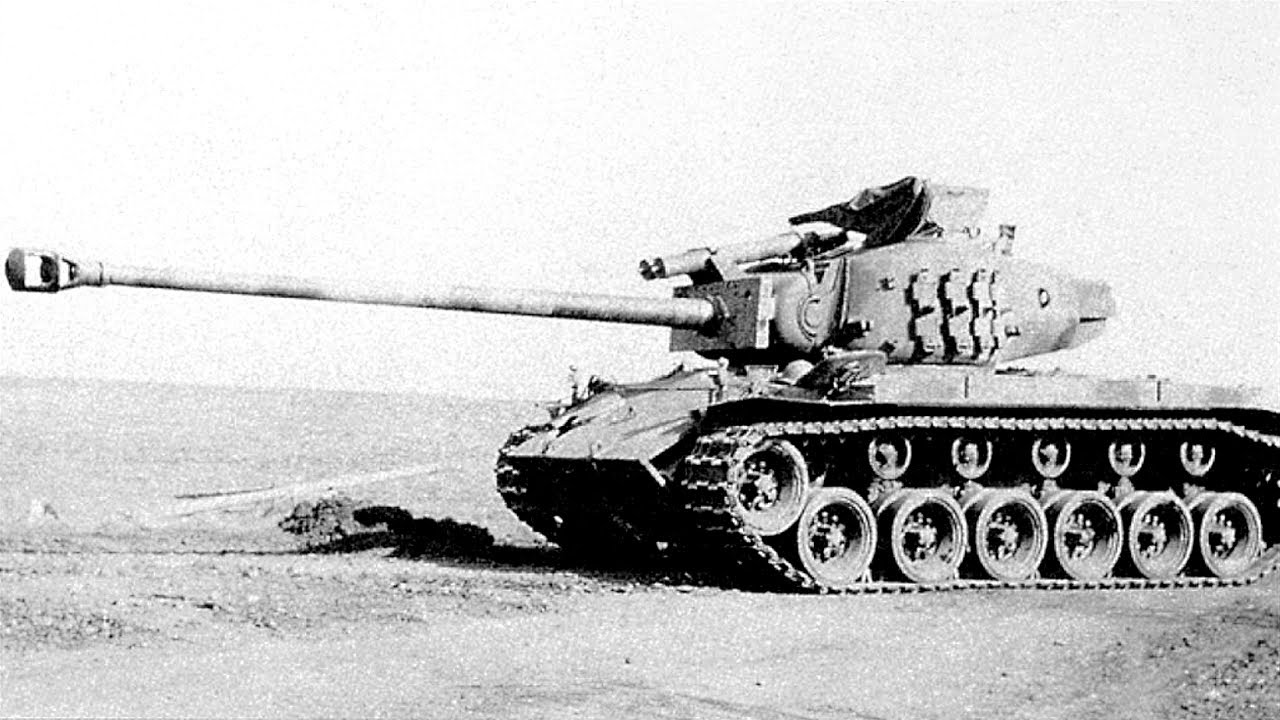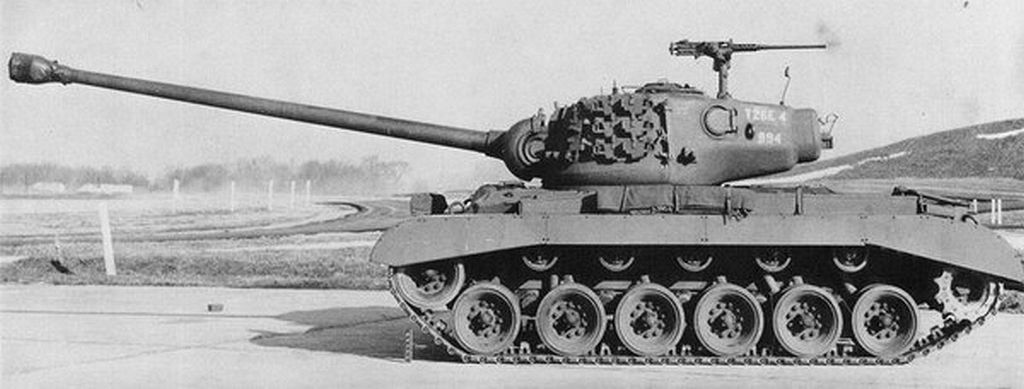Regarding AFV designs and utilization, the US Army during WWII of course focused on manufacturing economies and rail/cross-Atlantic transportability, and (at least through mid-1943) convinced itself that the Sherman was good enough against German armor; that its 75mm HE efficiency outweighed any AP limitations; and that it was the job of lightly armored tank destroyers, not tanks, to fight other tanks.
Especially from mid-1943 onward, the shortcomings of this analysis were recognized in some quarters. Shermans evolved toward 76mm guns mounted in more spacious T23 turrets, some Jumbos were fielded, and 76mm HVAP ammo became more commonly available. But, the original concepts by and large had considerable institutional momentum. The M26's arrival at the very end of the war was the beginning of the next generation, but WWII was essentially won by then. Fortunately for USA, the next generation of German tanks could not be fielded in significant numbers, and USA did not have to fight the Soviet Union's late-war tanks that did exist in larger numbers.
The M26's design was compromised by use of available subsystems per that manufacturing-economy focus, resulting in it having too little mobility. The Sherman and Sherman-like-TD experience with 75mm/76mm guns had shown that caliber class to be able to be optimized for either soft or hard targets, but not both. And, the medium-length 90mm M3 gun, even using HVAP ammo, was only adequate for engaging first-tier enemy tanks out to moderate ranges.
What if the US Army's collective thinking from 1943 onward had instead concluded that greater combat effectiveness should move up in the priority-stack as soon as possible...meaning that every front line tank (not counting scouts etc.) should be capable of engaging soft targets with maximum effectiveness and engaging other tanks when present?
The Army of course was structured with armor-supported infantry divisions for most sectors, and armored divisions for special tasks. The infantry divisions' tanks only required moderate mobility per their doctrinal tasks, and could rely on HVAP for engaging other tanks as long as the infantry tanks had at least 90mm medium-length guns. The armored divisions' tanks needed more gun capability and greater mobility.
The Sherman utilized the same turret ring diameter and drive systems as the M26. It was possible, without significant changes, to mount the T26 turret with 90mm M3 gun, as used on the M26, to a Sherman chassis. (Of course, ammo racks had to be changed and the standard load became smaller.) This combination was prototyped in 1944 by Chrysler, who were unable to convince the Army tank bureaucracy that its increased combat effectiveness would outweigh the systemic complexities of implementing such a change. The design was known as the "Persherman".

In this alternate proposal, this would have been adopted in late 1943 or early 1944 as the standard infantry-support tank. Existing US Army Shermans with low enough wear would have been field converted, using T26 turret/gun subsystems and new ammo-rack kits shipped to Europe. Production of all the TD versions for US use could have ceased, with all new US-use Shermans going to Europe already built as Pershermans. Because the T26E3's never-fully-resolved running gear and powerplant development issues would not have been in the way, this could have gotten 90mm tanks into the field many months ahead of when the T26E3 (which became the M26) finally reached Europe.
In this alternate proposal, the standard armored-division tank would have become the Super Pershing, with the gun and gun mount of the T26E4 (L/73 T15E2 90mm gun, two piece ammo, no external stabilizer springs required) and with the improved powerplant and suspension of the M26E2...those different design choices having been technically straightforward during WWII, but not implemented because of the same "manufacturing economy" thinking. The Super Pershing would have taken longer than the Persherman to field due to its greater number of technical developments, but it still could have been been fielded sooner than the historical T26E3 (M26) if per our alternate proposal, the infighting between Army Ground Forces, Armored Force and Ordnance had been much earlier resolved in favor of 90mm guns and greater tank combat capabilities.
Super Pershing with external stabilizer springs:

Super Pershing without external stabilizer springs:

(edited 6/3/2023 to fix dead image links)
Especially from mid-1943 onward, the shortcomings of this analysis were recognized in some quarters. Shermans evolved toward 76mm guns mounted in more spacious T23 turrets, some Jumbos were fielded, and 76mm HVAP ammo became more commonly available. But, the original concepts by and large had considerable institutional momentum. The M26's arrival at the very end of the war was the beginning of the next generation, but WWII was essentially won by then. Fortunately for USA, the next generation of German tanks could not be fielded in significant numbers, and USA did not have to fight the Soviet Union's late-war tanks that did exist in larger numbers.
The M26's design was compromised by use of available subsystems per that manufacturing-economy focus, resulting in it having too little mobility. The Sherman and Sherman-like-TD experience with 75mm/76mm guns had shown that caliber class to be able to be optimized for either soft or hard targets, but not both. And, the medium-length 90mm M3 gun, even using HVAP ammo, was only adequate for engaging first-tier enemy tanks out to moderate ranges.
What if the US Army's collective thinking from 1943 onward had instead concluded that greater combat effectiveness should move up in the priority-stack as soon as possible...meaning that every front line tank (not counting scouts etc.) should be capable of engaging soft targets with maximum effectiveness and engaging other tanks when present?
The Army of course was structured with armor-supported infantry divisions for most sectors, and armored divisions for special tasks. The infantry divisions' tanks only required moderate mobility per their doctrinal tasks, and could rely on HVAP for engaging other tanks as long as the infantry tanks had at least 90mm medium-length guns. The armored divisions' tanks needed more gun capability and greater mobility.
The Sherman utilized the same turret ring diameter and drive systems as the M26. It was possible, without significant changes, to mount the T26 turret with 90mm M3 gun, as used on the M26, to a Sherman chassis. (Of course, ammo racks had to be changed and the standard load became smaller.) This combination was prototyped in 1944 by Chrysler, who were unable to convince the Army tank bureaucracy that its increased combat effectiveness would outweigh the systemic complexities of implementing such a change. The design was known as the "Persherman".

In this alternate proposal, this would have been adopted in late 1943 or early 1944 as the standard infantry-support tank. Existing US Army Shermans with low enough wear would have been field converted, using T26 turret/gun subsystems and new ammo-rack kits shipped to Europe. Production of all the TD versions for US use could have ceased, with all new US-use Shermans going to Europe already built as Pershermans. Because the T26E3's never-fully-resolved running gear and powerplant development issues would not have been in the way, this could have gotten 90mm tanks into the field many months ahead of when the T26E3 (which became the M26) finally reached Europe.
In this alternate proposal, the standard armored-division tank would have become the Super Pershing, with the gun and gun mount of the T26E4 (L/73 T15E2 90mm gun, two piece ammo, no external stabilizer springs required) and with the improved powerplant and suspension of the M26E2...those different design choices having been technically straightforward during WWII, but not implemented because of the same "manufacturing economy" thinking. The Super Pershing would have taken longer than the Persherman to field due to its greater number of technical developments, but it still could have been been fielded sooner than the historical T26E3 (M26) if per our alternate proposal, the infighting between Army Ground Forces, Armored Force and Ordnance had been much earlier resolved in favor of 90mm guns and greater tank combat capabilities.
Super Pershing with external stabilizer springs:

Super Pershing without external stabilizer springs:

(edited 6/3/2023 to fix dead image links)
Last edited:
